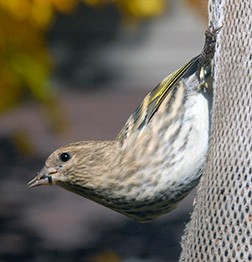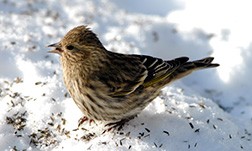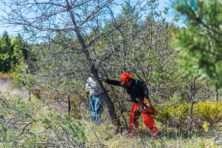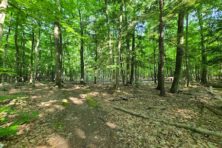The Pine Siskin
- Share
- Tweet
- Pin
- Share
An experience my Kewaunee friends Elmer and Millie DeCramer and I had on Dec. 28, 1958, is so indelibly etched in my memory bank that I shall never forget it. We were hiking the bottom-lands of the Kewaunee River conducting our first Christmas Bird Count when a small flock of Pine Siskins came into sight.
It was a magnificent little pocket of a climax Maple-Beech Hemlock woods, dominated in places by Hemlocks, that this fast-moving, lispy flock proved how tame they were as they fed ravenously upon the seeds of the Hemlock trees.
The beautiful forest was owned by our good farmer friend Ray Besserdich, and we knew that he too, had he been with us, would have thoroughly enjoyed the Siskins’ performance. What a thrill it was to stand beneath the conifers while the Pine Siskins fed within a few feet of you. What a great way it was to add a “lifer” to one’s bird list!
According to my journals of writing, it was in February of 1974 that I learned how easy it was to capture a Siskin by hand as it fed at one of the platform feeders. Several of these delicately striped creatures scratched about right beneath my outstretched hand, causing me to wonder whether I could make a fast move and catch one. So I tried, and caught one!
Immediately I went into our house (at the Ridges Sanctuary were we were living at the time) and told Charlotte about the fun I had catching a bird, and she asked, “Why didn’t you show it to me?”
So I promptly went out and caught another Siskin, brought it indoors and held it so Charlotte could make some sketches of it.
Holding one in the hand soon indicates how practically weightless they are, about 43-hundredths of one ounce. For those of you who have been so fortunate to have Chickadees feed from your hand, the Siskin is about one-20th of one ounce heavier!
The narrow sharp-pointed beaks especially attracted our attention as we closely studied this beady-eyed, undersized miracle of 20 degrees below zero weather. More than once in past years we’ve seen the aggressive Siskins flail their wings in defiance at the approach of other birds.
Quite regularly the “I was here first” bird will fly at the intruding Siskin, pecking repeatedly at the top of its back and head with its authoritative beak, both often flying several feet into the air, while the attacker appears to still be clutching onto the victim’s head feathers.
I wonder at times when the petite Pine Siskins suddenly puff out their feathers and hold the wings high over their backs and try to scare off even a larger bird, whether this is a defensive tactic somewhat similar to that which other birds and mammals, and even snakes such as the Puff Adder (Eastern Hognose Snake), use when attempting to frighten intruders or predators away.
Wide sweeping circular reconnaissance flights of the roughly 25 Siskins occur daily over our woods, perhaps accomplishing one of several things. They may be looking for the offerings of the forest such as cones on Eastern Hemlocks or seed catkins on the Paper Birches. The Siskins could also be on the lookout for their natural enemies, namely the Sharp-shinned Hawk and the Northern Shrike.
My guess is that the sudden but short flight may serve to warm their tiny bodies. In fact studies have shown that small birds such as Siskins and Goldfinches must shiver nearly continuously on very cold days to stay warm. Obviously you know how your blood circulation warms your body as you exercise. Undoubtedly the same phenomenon occurs for birds when they fly.
What short jerky steps the Siskins take as they feed upon the ground or the platform feeder. One can easily tell by watching them that they are not really at ease unless feeding in the trees where their nimble movements display to all who see that this is their specialty, this is their calling.
Our northern Door County winter bird counts began in 1964 and it wasn’t until 1971 that finally two Siskins were seen. Their appearance did not occur regularly until 1974, with 128 being counted, and continued uninterrupted through our biggest year, 1980, when 1,388 Pine Siskins were seen in late December.
Then quite mysteriously they were completely absent from this region during the winters of 1981 and 1982. We have seen them in rather small numbers every year since 1983, with 1987-88 being the second biggest for these feisty little “squirts.” There were 448 tallied on our Christmas Count of Dec. 19, 1987, 660 on our 2012 Sturgeon Bay Count, and I suspect strongly that their numbers have increased somewhat throughout northeastern Wisconsin during recent years.
Not at all to my surprise are the mixed feelings some people have about these sprightly northern visitors. Be glad that their erratic, unpredictable movements don’t bring them here every winter in large numbers and that you don’t live year around where they nest. Some gardeners, for example living in British Columbia, find it impossible to grow vegetables except under protective netting. Siskins relish young tender garden crops too!
Their primary food, come summer in their northern nesting environment, will consist of the seeds of alder, birch, willow, spruce, hemlock, thistles and other weeds, along with spiders, caterpillars, aphids, scale insects, giant lice, gall insects and grasshoppers. Apparently these tiny birds are very beneficial links in numerous food chains.
By all means don’t let the Siskins discourage you from feeding birds, whether it’s Nyger Thistle seeds or sunflower seeds they are after. It is absolutely vital to continue once the birds have become conditioned in their feeding habits to depend upon our handouts. Birds just may need you, and I know a lot of people who need the birds!
Hopefully their late autumn journeys each year will bring some of them back to this region where they will help bring us closer to Nature in many ways.




